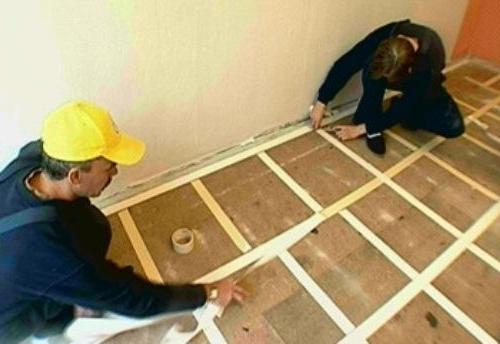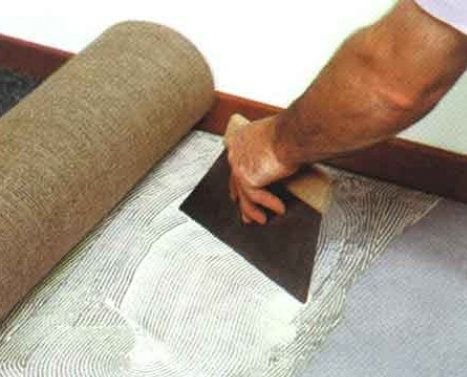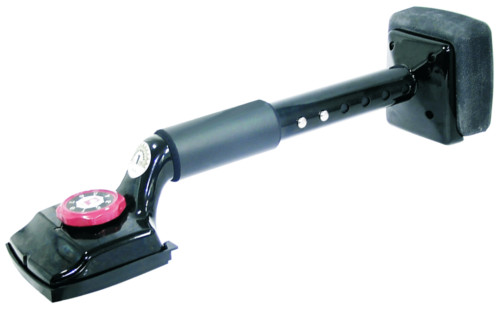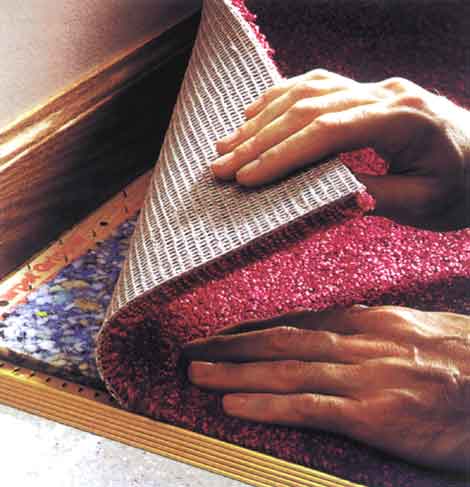Laying carpet is often used when finishing the interiors of apartments and country houses. This practical flooring creates comfort: the soft floor is pleasant to walk, and in addition, the carpet is an effective insulation. How to properly retain the carpet, tell me in this article.
Content
- What should be performed before laying carpet
- Preparation of the foundation and measurements
- How to raise carpet on concrete
- What a stealth under carpet
- How to retain carpet on linoleum
- Tools and materials required for work
- Types and rules of flooring carpet
- How to put carpet: review of different ways
What should be performed before laying carpet
Before starting the carpet flooring, the following conditions should be performed.
- It is necessary to finish all finishing work to exclude dirt and dust to cover.
- Carpet steaming on a solid and dry base, which should be aligned, purified from garbage.
- In the room there should be a minimum temperature of + 15 ° C, the humidity should not exceed 75%.
- Before starting laying the floor covering, carpet must be set aside during the acclimatization room.
- For the convenience of the door with the loops, it is necessary to remove and increase the gap between the web and the floor, so that during operation, it does not interfere with opening and closing.
Substrate Preparation and measurements
To lay carpet properly, you must inspect the room: all niches, ledges, openings and other features should be considered when cutting the material. Performed a sketch, which applied all the dimensions of the room. This is to ensure that the seller was able to correctly calculate the amount of carpet, measure the desired length and width.
Before laying the carpet should be evaluated:
- geometric parameters of the premises;
- compatibility with the standard size of the room size coating;
- perform coating markup cutouts in places (in partitions);
- should add about 5 cm on the edges of the floor covering to compensate for possible changes in the provisions of the carpet.
How to lay carpet on concrete
Stepwise process can be written as follows.
- Substrate preparation: Large cracks are sealed whereupon, with a significant difference, the surface is leveled by using self-leveling screeds or mixtures thereof.
- After drying, the base is removed dust and debris, and then the floor is treated with primer.
- Carpet is laid floating manner or fixed by special adhesive blend. Use double-sided tape in this case is not recommended in spite of the adhesion primer may be weak.
That the trail under the carpet
The carpet can be laid directly on the concrete surface, but preferably the substrate stack before. In that case, if the floor covering is a textile base, soft substrates used: based on the felt, foam or rubber. Carpet with rubber base paper substrate is required.
The substrate is required for:
- increasing the wear resistance and service life of the coating;
- smoothing irregularities in the substrate;
- improving the appearance of carpet;
- overlapping layers of adjacent floor space.
It is necessary to bear in mind that many manufacturers of flooring one of the conditions indicate the mandatory use of substrates.
How to lay carpet on the linoleum
Linoleum can serve as substrate for the carpet in the absence of blisters and ruptures. The base under the linoleum should be no hollows and bumps. Flooring plank in this case can be any of the known methods: floating, with an adhesive, using double-sided tape.
If the linoleum is badly damaged, in the presence of air bubbles and tears, it is better to get rid of, and to begin laying the carpet after repair base.
Tools and materials needed for work
Those who decided to fit the carpet independently, it is necessary to have:
- special knife with a set of replaceable blades and scissors;
- roulette and metal line;
- the blade for refueling carpet for infanes;
- grippers (rails equipped with spikes);
- double-sided tape;
- hammer;
- glue for flooring and processing of the canvas;
- ribbons hot and cold gluing;
- needle roller (for better docking);
- knee Tolkach (Stretcher).
Types and rules of flooring carpet
To decide how to lay carpet, it is necessary to determine the type of coating, the structure of the surface, the direction of the stacking of the pile. It is also necessary to take into account the direction of propagation of natural light and drawing. It is recommended to raise the carpet so that the pile of all parts of the floor covering is directed in one direction, and the elements of the picture coincided.
In order for the flooring to be laid high quality, the following requirements must be performed:
- The formation of air bubbles is not allowed: they may appear with an uneven application of glue, with a weak rolling and when laying an outdoor coating in conditions of high humidity.
- Seams should be made as secret as possible.
- The drawing on the place of the junction of neighboring sites is adjusted both in length and in width.
- Docking the canvas should be made so that the seams passed along the direction of propagation of natural light.
- Particular attention is required to pay the quality of the foundation: irregularities will cause uneven coating wear.
With carpet with a foundation from a natural jute, you must be careful when gluing: excess glue can pass through the basis and, penetrating to the pile, spoil it.
The following technologies are applied to laying carpet:
- fixation of the canvas with glue;
- fixation around the perimeter during free laying;
- stretching (tension);
- fixation with a scotch with free laying.
How to put carpet: review of different ways
Adhesive fixation
It is used in the premises of a large area and where high passability is assumed. The method is to apply glue to the entire surface of the base and laying the coating. The advantage of the method is in the guaranteed absence of wrinkles, swirling and other deformations. The process in stages can be represented as follows:
- pre-lined surface is cleaned from garbage and dust;
- with the help of a toothed spatula, glue is applied to the base and is evenly distributed over the surface;
- a substrate is pasted (on large areas - parts);
- after drying, the glue carpet is spread on the floor so that the edges enter the walls;
- the canvas folded in half, after which the glue is applied to the back side of one half;
- we decide the part of the canvas with glue on the floor, while tightly pressed and align;
- similarly, we do with the second part of the floor covering;
- tightly pressing in the corners, cut the carpet near the walls;
- using the knee strrestcher-kicker, customize the coating under the plinth, which is secure self-drawing to the walls.
The advantages of this method is that the carpet serves longer than with other methods of laying. There is a possibility of laying several panels. The appearance of bubbles and folds is practically excluded. The coating can be cleaned with a detergent vacuum cleaner. Disadvantages - high laboriousness and inability to reuse coverage. If there is a "warm floor" system, it is necessary to take into account the temperature limits of glue in the process of operation to avoid its destruction.
Free laying with fixation around the perimeter
This is a simpler and cheap way than the previous one. No application of scotch, glue and flupers are required. Disadvantages: The appearance of folds and bubbles is possible, which reduces the service life of the carpet. The method is not suitable for facilities with furniture on wheels. Cleaning with detergent vacuum cleaner is impossible. The coating flooring on this technology is as follows:
- the base surface is cleared;
- stacked and fixed by the substrate brackets (interval - 200 mm), connecting with the help of tape;
- carpet rolled on the basis of about 100 mm in the walls;
- the side of the coating with the edge decorated by the factory method is pressed against the wall and fixed by the plinth;
- the material stretch is performed under the rest of the walls, after which it is clipped in the corners and is fixed by the plinth;
- in the area of \u200b\u200bthe doorway thresholds, the coating is pressed with a metal rail.
Free Laying with Scotch Fixation
The method is convenient for small rooms, but requires high-quality alignment of the foundation. For laying, two-way tapes of various widths are used - from 63 to 150 mm. It glues at the beginning of the perimeter of the room, then over the entire area in the form of a 500 × 500 mm lattice. Protective paper tape is not deleted.
A carpet with reserves along the edges of about 100 mm is placed on the base, after which the actions are produced similarly to what prescribes the adhesive method. As the carpet rolling rolls, a protective film with a tape is removed. Surplus coating are removed after circumcision at the place of the joint with the wall.
This method allows you to stick a few cloths and shoghes them with each other, and also use the material again. Besides:
- no need to use the substrate;
- the method is suitable for the "Warm floor" system;
- the basis can serve as laminate, parquet, tile, linoleum and laminated chipboard.
The disadvantages of this method of fixation: the formation of air bubbles and folds is not excluded, and tape can not withstand high humidity and temperature fluctuations.
Tension Method (Stretching)
For fixing carpet, with this method, rains (flupers) are used with clogged under 45 ° angle with two rows of nails. A special tool for tensioning the coating is needed to work - Stretcher or Kickker. It should be borne in mind that a knee stretcher is best suited for small premises, and the string is used in large.
Laying the carpet with this method is carried out in several stages:
- Preparation of the basis;
- Along the walls, grippers are fixed, nails oriented from the center of the room;
- The substrate is laid and fixed with brackets (fixation step - 200 mm);
- Carpet is placed to the wall of the edge decorated at the factory;
- The edge of the material is attached to the flu (with the help of a kickbox or stricther): the teeth of the fixtures are set to about two centimeters from the rail, after which they hit the pillow: it records carvilines on nails;
- Turning the coating of the turnover: the movement starts from the corners;
- The strict teeth are inserted into the floor covering at a distance of about 150 mm and fixed, after which the kickker ends are stretched into flu in each direction;
- excess material can be adjusted or trimmed;
- At the perimeter of the room is installed plinth.
Upon completion of laying, glue (tape) must completely dry, before indoors, the furniture can be arranged and walk. The right choice of the method of laying the carpet will make the room with such an outdoor coating with cozy and comfortable for many years.
At the end of the article on how to raise carpet - video, visually demonstrating the process.



























